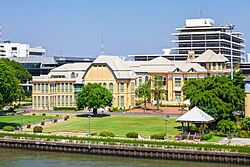Bank of Thailand facts for kids

Seal of Siam Devadhiraj, guardian deity of Thailand holding a money bag and a sceptre
|
|

Bang Khun Phrom Palace
|
|
| Headquarters | Phra Nakhon, Bangkok, Thailand |
|---|---|
| Coordinates | 13°46′08″N 100°30′03″E / 13.7689°N 100.5009°E |
| Established | 28 April 1942 (legal) 10 December 1942 (began operations) |
| Governor | Sethaput Suthiwartnarueput |
| Central bank of | Kingdom of Thailand |
| Currency | Thai baht THB (ISO 4217) |
| Reserves | US$243.49 billion (2023) |
| Bank rate | 2% |
The Bank of Thailand (BOT) is like the main bank for the country of Thailand. It helps keep the country's money system stable and strong. The BOT makes sure that the Thai baht, which is Thailand's money, is reliable. It also works to help the country's economy grow in a healthy way.
Contents
History of the Bank of Thailand
The Bank of Thailand (BOT) started a long time ago, on December 10, 1942. It was first called the Thai National Banking Bureau. A special law, called the Bank of Thailand Act, was made on April 28, 1942. This law gave the BOT the important job of being the country's central bank.
Later, this law was updated in 2008. The new law made sure the bank also focused on helping society and preventing money problems. It also made the bank's decisions clear and fair for everyone.
Project Nexus: Connecting Payments
The Bank of Thailand is part of an exciting new project called Project Nexus. This project started on June 30, 2024, with other central banks from countries like Malaysia, the Philippines, Singapore, and India. It's like building a super-fast highway for money!
By 2026, this project will make it much easier and quicker for people in these countries to send money to each other. It connects their local fast payment systems, making cross-border payments simple and quick.
What the Bank of Thailand Does
The main goal of the Bank of Thailand is to make sure Thailand's money system is steady and reliable. This helps the country's economy grow in a healthy way. When the economy is strong, it helps everyone in Thailand have a better life. The BOT works to keep prices stable and prevent big economic ups and downs.
Governors of the Bank
The person in charge of the Bank of Thailand is called the Governor. The Governor has a very important job, leading the bank and making big decisions about Thailand's money. A Governor serves for five years and can be chosen for up to two terms.
The Minister of Finance suggests a candidate for Governor to the Thai Cabinet. If the Cabinet agrees, the candidate is then presented to the Monarch for final approval.
List of Governors
| # | Name | Started Job | Left Job |
|---|---|---|---|
| 1 | Prince Vivadhanajaya | 27 November 1942 | 16 October 1946 |
| 2 | Serm Vinicchayakul | 17 October 1946 | 24 November 1947 |
| 3 | Leng Srisomwongse | 25 November 1947 | 2 September 1948 |
| 4 | Prince Vivadhanajaya | 3 September 1948 | 2 December 1948 |
| 5 | Leng Srisomwongse | 3 December 1948 | 3 August 1949 |
| 6 | M.L. Dej Snidvongs | 4 August 1949 | 29 February 1952 |
| 7 | Serm Vinicchayakul | 1 March 1952 | 24 July 1955 |
| 8 | Kasem Sriphayak | 25 July 1955 | 23 July 1958 |
| 9 | Jote Guna-Kasem | 24 July 1958 | 3 May 1959 |
| 10 | Puey Ungphakorn | 11 June 1959 | 15 August 1971 |
| 11 | Bisudhi Nimmanhaemin | 16 August 1971 | 23 May 1975 |
| 12 | Snoh Unakul | 24 May 1975 | 31 October 1979 |
| 13 | Nukul Prachuabmoh | 1 Nov 1979 | 13 September 1984 |
| 14 | Kamchorn Sathirakul | 14 September 1984 | 5 March 1990 |
| 15 | Chavalit Thanachanan | 6 March 1990 | 30 September 1990 |
| 16 | Vijit Supinit | 1 October 1990 | 1 July 1996 |
| 17 | Rerngchai Marakanond | 13 July 1996 | 28 July 1997 |
| 18 | Chaiwat Wiboonsawat | 31 July 1997 | 4 May 1998 |
| 19 | M.R. Chatumongol Sonakul | 7 May 1998 | 30 May 2001 |
| 20 | M.R. Pridiyathorn Devakula | 31 May 2001 | 6 October 2006 |
| 21 | Tarisa Watanagase | 8 November 2006 | 30 September 2010 |
| 22 | Prasarn Trairatvorakul | 1 October 2010 | 30 September 2015 |
| 23 | Veerathai Santiprabhob | 1 October 2015 | 30 September 2020 |
| 24 | Sethaput Suthiwartnarueput | 1 October 2020 | Present |
See also
 In Spanish: Banco de Tailandia para niños
In Spanish: Banco de Tailandia para niños
- Thai baht
- Economy of Thailand
- Bank of Thailand Museum
- List of central banks

